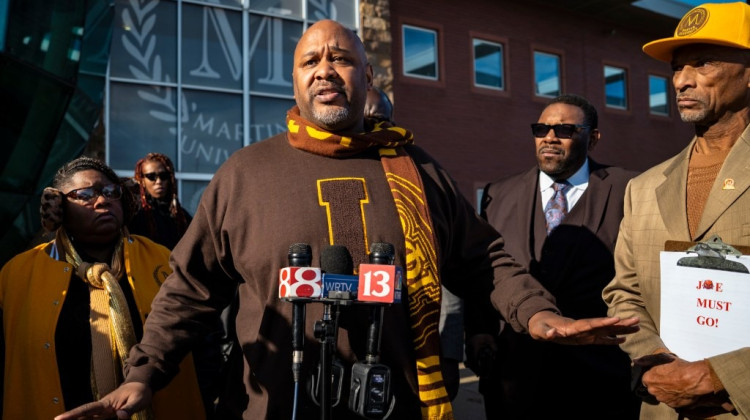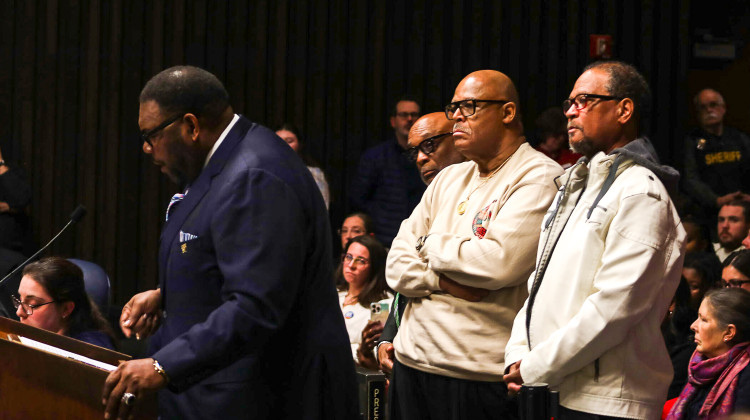
Purdue University's current plan commits to cutting carbon emissions in half by 2025.
Ben Thorp/WBAAUntil this month, neither of Indiana’s two largest colleges had a plan for going carbon neutral. Indiana University announced a new Climate Action Plan Sept. 11, and Purdue University is the holdout.
Almost every other Big 10 university has committed to a carbon neutral plan. The University of Iowa is the other exception in addition to Purdue.
Michael Johnston, an associate professor of English, founded the Purdue Climate Action Collective in late 2022, hoping to see more commitments from his university to combat climate change. The group’s main goal is to see Purdue create a plan by the end of 2023 to eventually reach carbon neutrality.
“The fact that we're so far behind, and that we are a university that prides itself on innovation, and science and technology, it seems like this is a missed opportunity for Purdue,” Johnston said. “We ought to be taking a leadership role.”
Carbon neutrality means the amount of carbon emitted is equal to the amount absorbed by the atmosphere.
Purdue’s current goal is to cut its emissions in half by 2025, and it's part of a five-year planending that year. Purdue University and Duke Energy found this year small modular adapters,which use nuclear technology, could be a carbon-free energy solution on campus. However, Purdue and Duke have not put this in place.
Indiana University’s Climate Action Plan aims for carbon neutrality by 2040. Johnston joked he’d like to see the Purdue and IU rivalry continue with their sustainability plans.
“What I would love to see Purdue do is commit to carbon neutrality by 2039 as a fun way to rib IU,” he said.
A report from Purdue’s Indiana Climate Change Impacts Assessment showed Indiana average temperatures have already risen 1.2 degrees and with “significantly more warming by the century’s end.” The reports also projected that the state is more at risk for flooding, water pollution and stress on farming and drinking water.
“Projections show the pace picking up even more speed as heat-trapping gases, produced by humans burning fossil fuels, continue accumulating in the atmosphere,” the report said. “Indiana will continue to warm, more precipitation will fall, and extremely hot days will be common in many parts of the state.”
In an email spokesperson Tim Doty said the university has been named a 2023 U.S. Department of Education Green Ribbon School and earned an AASHE STARS silver rating for sustainability.
Johnston said he understands a carbon neutral plan won’t materialize overnight and he is happy the university is making some progress. He said the university has been open to conversation and has met with Senior Vice President for Administrative Operations Michael Cline.
Purdue’s community seems to support Johnston and the Climate Action Committee’s mission.
Johnston said the group has about 100 faculty and over 200 students involved. Collaborations with other student sustainability groups on campus boost those numbers closer to a thousand, Johnston said.
Students, many of whom study environmental and ecological engineering, are energized, Johnston said, because they’ll have to live longer with climate issues.
“It’s a lot easier to see progress when you're just working with groups of people,” Johnston said. “The work with the students and faculty has been fantastic.”
The University Senate passed a resolution in the spring to support a climate neutral plan, and the Greater Lafayette Climate Plan has also made commitments to drastically reduce carbon emissions.
Johnston said the Purdue Climate Action Committee’s goals for this semester are growing membership, formalizing outreach to students and faculty and creating a centralized online presence.
“This semester, our goal is to really try to bulk up our membership,” Johnston said. “So that we can have a large voice when we're ready to really make a push if the university hasn't done anything in the interim.”
 DONATE
DONATE







 Support WFYI. We can't do it without you.
Support WFYI. We can't do it without you.